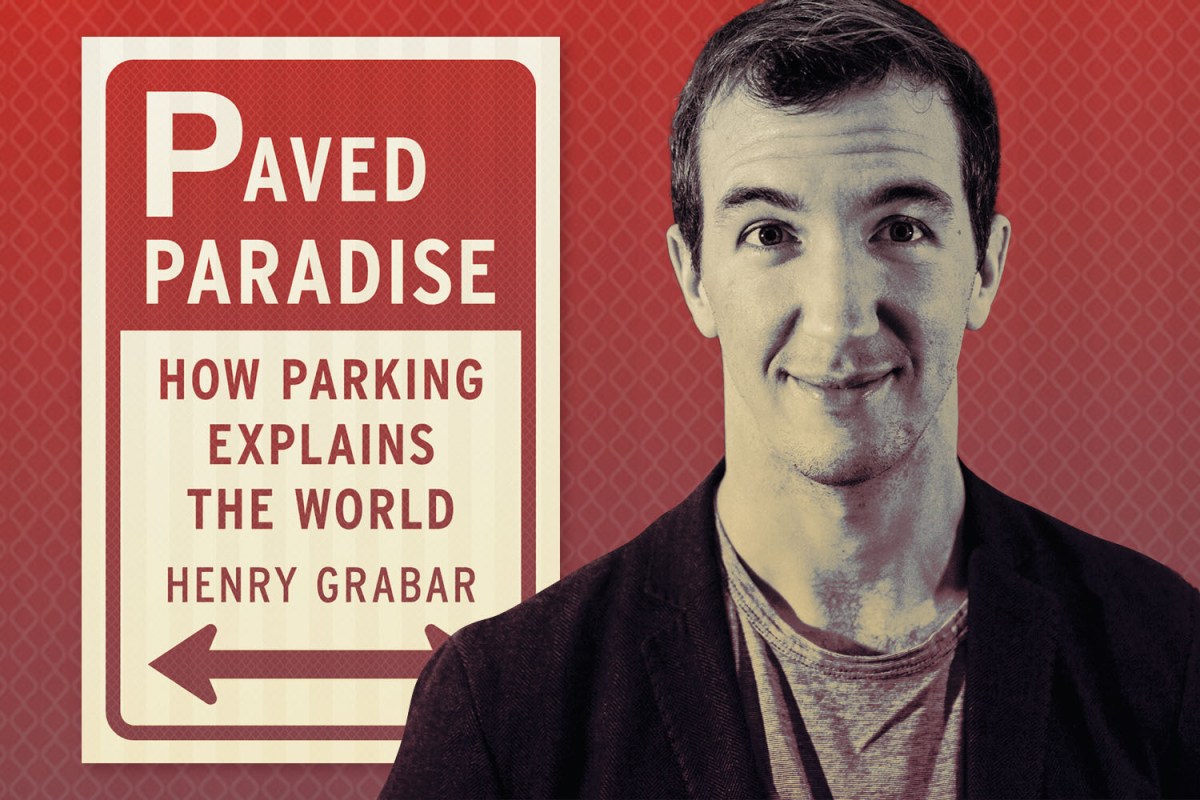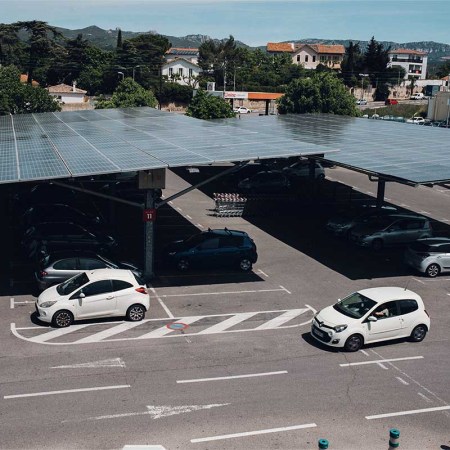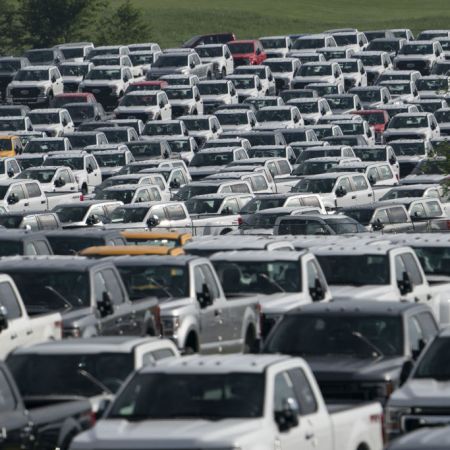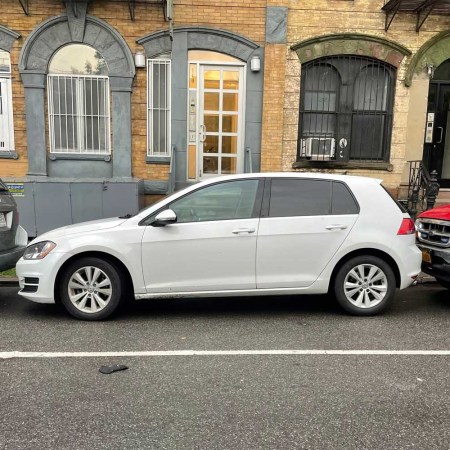Henry Grabar has a very compelling argument he’d like to make about cities, cars and housing. It’s one that has a bearing on the lives of countless people, from someone seeking affordable housing as rents escalate to a small business owner trying to find the right place for a new store. Reading Grabar’s new book Paved Paradise: How Parking Explains the World offers a very different lens through which to view some of the biggest issues facing the country.
Grabar — who also writes regularly about urban planning and infrastructure for Slate — uses his book to trace the different ways that parking spots have shaped the way people live all over the country. His conclusion? That rethinking decades-old zoning laws as they apply to parking could make it a lot easier to build more housing, as well as preserving beloved older buildings. InsideHook spoke with Grabar about the genesis of his book and the questions it raises about cities and design. An edited version of our conversation follows.
InsideHook: Was there one inciting incident that started you on the process of thinking about the different aspects of Paved Paradise and how they’d converge?
Henry Grabar: There was a moment for me when it clicked. I was in Sao Paulo in Brazil and I was on vacation. I was walking through this very hilly neighborhood and it started to rain really hard all of a sudden. I ducked into this little cafe and was standing there with all these other people who were taking shelter from the rain.
There was a garage across the street and the guys who work in the garage, they’ve got all the cars they’re working on in the street and they’re running into them one by one, starting them and driving them away, and then running back and driving another one away.
It keeps raining. And in about 15 minutes, the entire street was a river, a torrential raging torrent of water. It’s carrying garbage bags and pieces of construction equipment and cars, like cars floating like bath toys in the street, which is why all those guys were moving the cars. I was just in the middle of a flash flood, which I had never experienced before, especially not in the city.
It was one of those moments where it just clicked for me that the entire urban environment has been terraformed by all this asphalt we put down. Sao Paulo is not a city that has a ton of parking lots, but nevertheless, it prompted me to consider cities as being these gigantic organisms that are composed mainly of asphalt and concrete, and to think of them as environments that way. That made me see parking as the dominant force in the urban environment that it is. And that was the moment where I thought, wow, this is something worth looking into.
In Paved Paradise, you argue that car parking explains many of the reasons why there is a dearth of housing in cities. Do you think this hasn’t been discussed more because a lot of people are in the position of taking parking for granted, as opposed to something that can be adjusted or manipulated to make the design process and the planning process more streamlined and better for everyone?
I don’t know if I would use the expression “taken for granted.” I’ll say that I think parking is overlooked. For a long time, it has been absent from the curricula for people like engineers, architects, city planners, all those people. This wasn’t really an area of study until Donald Shoup got into it. So in that way it was overlooked, but I think also in a more popular sense, people just don’t think about it critically. And so the reason that the book is necessary was also the challenge in writing it, which is that parking is boring.
Nobody wants to think of it, there are no movies about parking and nobody likes to look at parking lots, really. It is something that easily slips from your mind. And so I understand how, when we think about cities and we think about the building blocks of what makes a place what it is, parking isn’t the first thing that comes to mind — or the second. In fact, it might be the last, especially when it comes to cars.
I mean, there’s been so much written about automobiles and about streets and roads and highways. And it’s true that highways were this enormous, colossal change that was wrought on US cities in the 1950s and 60s. And honestly, it’s still happening. But you know, let’s remember the part the car spends 95% of its time parked. So if you want to think about the impact of car culture on cities, parking is the place to go. But I agree, it’s not self-evident.
People seem to be driving larger and larger vehicles in the United States. Has that also played a role in the debates over parking — the way that an average-sized car from 20 years ago and an average-sized car now might be two very different sizes?
That’s a great question. Aaron Gordon wrote a really interesting article about this a few weeks ago that I feel like I should plug because that gets at this exact question. I think it’s not as cut and dry as you would think, in part because while cars are really, really large now, I think the most noticeable change is that they’re getting much higher off the ground. That might affect the verticality in a parking structure, but it’s not going to affect the size of the space.
The other thing is that to the extent that cars are also longer and wider — which they are — they are wider than they were 20 years ago. But we also had very large cars in the 1950s and 60s before the oil crisis. So a lot of our parking environments aren’t quite as outmoded as they would be had they ever been built for compact cars in the first place. But I don’t mean to dismiss the idea entirely that the big cars are challenging the parking status quo.
I think one thing you notice if you travel to Europe or Japan is that many more people drive very, very small cars verging on what we might think of as micromobility, almost like golf cart-esque — Smart cars, that kind of thing. When you start to think of a city as being composed of those and lots of people drive those, you really do unlock a lot of efficiencies in how many cars can be fit on a street, in the way that parking becomes a third rail.
If you have a small car, it’s just that much easier to park. I think people have adapted to tight urban environments in other places by getting smaller cars, and that in turn eases the parking situation for them and for the city as a whole. I don’t see that happening in the US anytime soon, in part because the cars are so big.
Even driving a sedan on an American road these days, it feels a little unsafe because you’re surrounded by cars that have been designed to protect their occupants in the event of a crash, but not to protect you. On the contrary, one of the reasons they’re so safe is because their car is not going to be impacted when it runs into yours. So if you’ve ever felt that glare of the headlights of the pickup that’s six feet off the ground behind you on a road, I think you’ll appreciate that, even if big cars aren’t necessarily changing the parking paradigm, they’re definitely making it less pleasant to own a small car.
Another subject you touched on in Paved Paradise was the fact that there have been very few attempts to make a parking garage that was also a great public space. Was there ever a movement to do that or was it always a case of garages being as bland and utilitarian as possible from the outset?
I think there was a moment when architects imagined that parking garages would become these grand civic destinations on par with European train stations. There are a couple examples of architectural ingenuity being applied in the form of a parking garage. Temple Street Garage in New Haven is a nice one by the brutalist architect Paul Rudolph. There’s a more recent example in Miami Beach by Herzog & de Meuron. But I think at the end of the day, everybody’s trying to save money on parking. And I’m not talking about the drivers. I’m talking about people who build parking because parking is really expensive to build.
People in the parking business say they’re in the hospitality industry — which is, in my opinion, BS because what they’re actually doing is sort of a commodity. Nobody wants to get out in a parking garage that feels really, really unsafe. But people are just not willing to pay for parking that stands out, that is of a higher quality. If people are paying more for parking, it’s for valet parking, in which case they’re not even seeing the inside of the garage anyway. So there’s very little incentive for garage builders to go above and beyond the bare minimum there.
When you talk about lots, there are definitely ways that lots can be made more pleasant. It’s not necessarily an architectural innovation, but something as simple as planting a bunch of trees. But again, nobody’s choosing their destination based on the quality of the parking lot. And so it seems unlikely that pretty much any type of commercial landlord is gonna spend an extra buck to make a really nice parking lot.
You also address the ways that requirements for parking spaces can limit what else can be built in an area, whether it’s retail or housing. In researching Paved Paradise, was there anything that surprised you as far as a way that a parking lot was an impediment to something that could have been much better for a community or for a city?
I think the biggest surprise there is around adaptive reuse. So, obviously these parking rules apply in most jurisdictions in this country to new buildings. So if you want to build a new restaurant or a new condo or a new mall or whatever, you have to include a certain number of parking spaces, which are allotted according to some obscure and pseudo-scientific formula. We can get into that later on.
But at the end of the day, new buildings require all that stuff. But old buildings and historic buildings also require that same amount of parking if you’re changing the use. And what that means is that pretty much any historic structure in an American city cannot be reused as anything besides its original purpose without providing the requisite amount of parking that would be expected of a new building. And that is just a massive, massive obstacle to reusing historic structures.
There have been countless historic structures — I’m not using historic with a capital H; they have historic importance, but just they’re built. They’re part of the fabric of a place. They’re part of its history and its culture. And they’re torn down because they cannot be reused without first building a parking lot.
I was talking to an architect in Ann Arbor about this — Ann Arbor, Michigan, which has since, by the way, repealed parking minimum. Ann Arbor is on the path towards a better future. But they were describing buildings in Ann Arbor that they considered basically padlocked. Like, just don’t even try it. You can’t open a restaurant there. You can’t open a brewery there. You can’t open an art gallery because all of those uses require new parking that this historic structure doesn’t have. And so you’re left with the choice of moving on and building something new in the suburbs or tearing down the building next door. And I think both of those options are pretty deleterious to creating a vibrant city. And unfortunately that’s been the status quo for the last 50 years.
The descriptions in the book of existing buildings needing to be bought and demolished for parking were eye-opening.
If you look at an American downtown like Tulsa or something like that, there is just so much surface parking. It is the largest single use of land downtown. And if you color code it — as urbanists on Twitter like to do — they create these little viral maps where the parking lots are color coded and you just see the entire downtown lit up yellow or red in a place like Tulsa or Little Rock or something like that.
You can look at all that parking and say, it’s hard to tell sometimes if it was created through neglect, like people tearing down buildings because there was no economic reason for them to continue to exist. They couldn’t rent them out, or it wasn’t worth keeping up with the repairs. But a lot of them are required by law and they correspond to buildings next door.
Especially in small towns, this just feels so counterproductive to the revival of a small town. Because in small towns especially, there really is always enough parking. And so to require that every building have a parking lot, literally adjacent to it, you’re just asking for your city to be broken up, and making it impossible for people to walk.
Before I read your book, I was unaware of the methods used to calculate how much parking was required for a specific building. I grew up near a mall in suburban New Jersey and there are spots in its parking lot that I’ve never seen occupied, even during the holiday shopping season.
That’s by design. One of the things about these requirements is that they calculated according to these very weird rules. They’re all different; for one thing, sometimes these requirements are based on objects — they’ll say you have to have this many parking spots corresponding to the number of pumps at the gas station, or this many parking spots corresponding to the square footage of the dining area in the restaurant, and this many parking spots corresponding to the number of seats in the theater or lanes in the swimming pool or whatever. They have all these different baselines by which they calculate these numbers.
But the other thing is, they calculate the number of parking spaces required based on what they think of as the busiest possible time of use or nearly the busiest possible time of use, which means that by design, if you go to a shopping mall, you are going to have lots and lots of empty parking spaces almost every day of the year. And it’s designed so that often the standard is the 20th busiest hour. So you want to have enough parking to accommodate the 20th busiest hour of the year, which means 19 hours out of the entire year people might have to look for a parking space before pulling it immediately. And the rest of the year there’s too much parking.
What you’re looking at is not a mistake. That’s the way it’s supposed to be. And to make matters worse, all that parking is also built to the maximum possible occupancy of the site. So it’s pretty rare for a mall or an office building or residential building to be 100% occupied, but the parking lot is always built to assume that it is.
Elsewhere in Paved Paradise, you brought up the privatization of Chicago’s parking meters and the numerous ways in which that deal was bad for the city. In your research for the book, did you come across any other cases where municipal governments made deals like this that also turned out badly for the cities?
There were a number of places that were considering it, but the Chicago deal was so notorious that for a minute, at least, it basically turned everybody off the idea of selling off parking spaces. What happened in Chicago was a disaster, a total fiasco. But I think the reason that it was a disaster was because the city got taken advantage of by this group of savvy investors that they were negotiating with.
It’s not even that the group of investors led by Morgan Stanley were that savvy so much as the city was just that negligent in thinking this through. I don’t think it’s impossible that a private company could manage meters in such a way that would improve the situation on city streets. One thing I will say, though, is that if you’re going to lease out your parking meters to somebody who’s just trying to make as much money as possible, you’re never going to end up with an optimal situation for the streets.
I think a more interesting scenario that has come to pass since Chicago did that is what’s going on in San Francisco, where they have introduced what they call dynamic pricing on the streets and in the garages.
And the goal of this pricing system that they have in San Francisco is — unlike Chicago — not to make as much money as possible from people parking there, but rather to make sure that there is always available parking space. And so they use the pricing to nudge people from the busiest parts of town, where it’s hard to park, onto the blocks where it’s easier to park — and especially into the garages, which are almost never full, and were never full before.
What you have now is a situation in San Francisco where the busiest destinations did get more expensive when they introduced the system, but the garages got a lot cheaper. And I think that that’s an example of how better parking management probably doesn’t mean that the city is just trying to take every last dime out of the driver’s pockets. It’s really that charging for parking is the only way we have of organizing this system. And obviously if you do a Chicago-style thing where you lease your parking out to a bunch of bankers, then you’re going to get a system of organization that’s designed exclusively around profit, and that’s not going to be good.
Inside a Harvard Professor’s Ambitious Work of Cultural History
Martin Puchner, the author of “Culture: The Story of Us, from Cave Art to K-Pop,” talks about the challenges of writing a wide-ranging historyDo you see glimmerings of hope for improved policies going forward regarding parking? If so, do you think that’s going to be done more on the local level, more on the federal level or more on the state level?
I think there’s a lot of exciting things happening at the local level. There’s obviously a very serious housing crisis in this country right now. A lot of cities have recognized that requiring parking imposes a huge cost on new development. And so you get more expensive housing and you get less of it. There’s been this huge movement to repeal these laws that require that every new unit come with one, two or three parking spaces, et cetera. And that has just taken off like wildfire in the last three years. I mean, I can’t even name all the cities that have gone and undone these 50-year-old laws. Obviously, developers still can build parking if they want to, but they don’t have to. And that opens up all kinds of interesting possibilities for how that parking can be provided, whether it’s provided at all. You leave renters and owners with the choice of whether they want to pay for parking instead of having it bundled into their lease automatically. I feel very optimistic about that.
The other part of that that makes me less optimistic is I think to some extent, those reforms are based on the idea that people will gradually reduce their car ownership. And it’s true that we know that people are more likely to own cars if they have a dedicated parking space. So perhaps if those laws are repealed and developers build less parking, then people will own fewer cars, maybe. But the other thing that has to happen is that the streets also have to be designed to permit people to get around safely and easily without cars.
On that front, I am much less optimistic because I feel like even with one hand, cities are saying owning a car should be a choice. We want to encourage new kinds of mobility. We want to get people out riding bikes, et cetera. And then you look at the streets in those same cities and — this is not a safe place to ride a bike with a child. I understand why somebody would buy a car if they had to take their kids to a little league game every week. And so you really can’t reform the question of parking being included with every unit. It has to come in tandem with this cycle of positive land use and transportation reform, where you make it safe and easy to get around without a car.
This article appeared in an InsideHook newsletter. Sign up for free to get more on travel, wellness, style, drinking, and culture.























